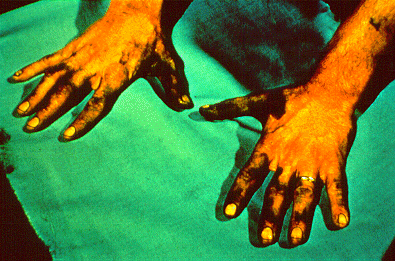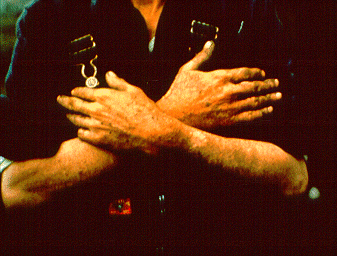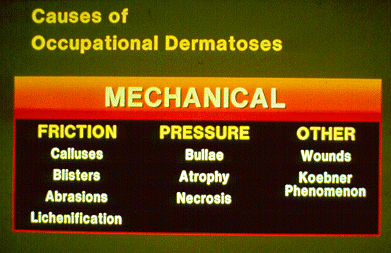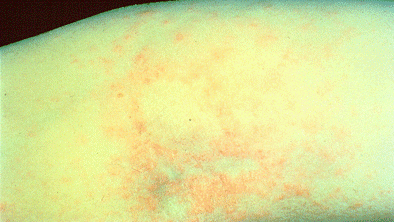Occupational Dermatoses
NOTE: This page is archived for historical purposes and is no longer being maintained or updated.
Slides 56 to 60
Slide 56 - Stained hands in foundry worker

Foundry workers using a no-bake sand binder with an oil base may develop an exogenous discoloration which is very difficult to remove. The binder not only binds sand to sand, but also binds dirt to skin.
Slide 57 - Pitch warts

Pitch warts represent a type of skin reaction to several chemicals that cause epidermal hyperplasia, which may be associated with tumor or cancer formation. Certain petroleum intermediates and products, retorted shale oil, coal liquification intermediates, a number of coal tar derivatives and arsenic can stimulate the epidermal cells to produce these effects.
Slide 58 - Mechanical

Second to chemicals in order of frequency and importance are the mechanical causes of occupational dermatoses. Friction produces calluses, blisters, abrasions and lichenification. Pressure causes bullae, skin atrophy and necrosis. Other trauma brings about the Koebner phenomenon in which a dermatosis localizes itself at the site of trauma.
Slide 59 - Callosities

Here you see calluses and fissures produced by repetitive hand motion and by the use of certain types of tools.
Slide 60 - Fibrous glass

Contact with fibrous glass, particularly of large fiber diameter, can produce itching, but lesions are seldom visible expect for secondary effects from rubbing or scratching. Commonly affected sites are flexural areas and where clothing is restrictive. In some individuals, especially those with dermographism, small erythematous papules may occur where the spicules have penetrated, as shown here.
- Page last reviewed: January 5, 1998 (archived document)
- Content source:
- National Institute for Occupational Safety and Health Health Effects Laboratory Division (HELD)


 ShareCompartir
ShareCompartir